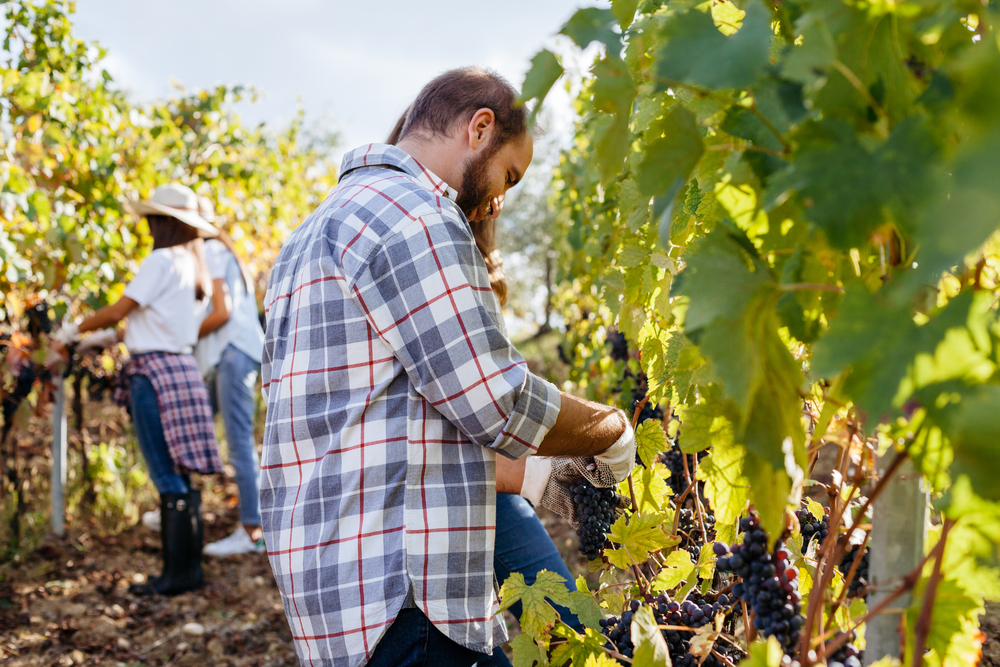Harvest season is a magical time, yet demanding time at Gluck Estates in Etyek, Hungary. The entire vineyard buzzes with anticipation as months of hard work culminate in this one moment the picking of grapes that will eventually become our premium wines. Working as a winemaker in Hungary, with years of experience, I’ve learned that harvesting at Gluck Estates is about much more than simply collecting ripe grapes; it’s about ensuring that every grape we pick is a testament to the care and passion we invest in our vines. Every worker, from the pickers to the cellar hands, plays a vital role in bringing out the best in our wines.
Early Morning in the Vineyard
The day begins early, often before the sun has fully risen, because the cool morning air is crucial for preserving the freshness of the grapes. I’ve always believed that the morning atmosphere sets the tone for the harvest. Walking through the dew-covered vines with the crispness of the air around you, you feel the connection between the earth and the fruit. The pickers arrive just as the fog lifts, their faces reflecting a deep respect for the vines they are about to tend to. Many of these workers have been with Gluck Estates for years, some even decades, and their expertise shows in every move they make.
Hand-picking grapes is an art form in itself. Every vine is a story—its growth, the challenges it faced through the season, the way it adapted to the weather. The pickers, who are often local to the region, understand this story. They’re not just laborers; they’re individuals with a passion for wine and a respect for the land. Some have grown up in the vineyards, and their knowledge of how to select the perfect bunch is unparalleled. They know that the tiniest flaw in a grape cluster could affect the entire batch of wine, and they are meticulous in ensuring that only the best makes it into the basket.
The Relationship Between the Pickers and the Vines
One thing that sets Gluck Estates apart is the relationship between the pickers and the vines. The respect for the land and its bounty is mutual. The vines, particularly for delicate varietals like Pinot Noir, seem to respond better when handled with care. The pickers here treat the grapes as if they are gold, cradling each cluster as they place them in the buckets. There’s no rushing, no cutting corners—each grape is inspected before it’s snipped. This attention to detail ensures that only the highest quality fruit is brought to the sorting table.
I’ve worked harvests where mechanical pickers were used, and while machines can be efficient, they don’t have the same finesse as human hands. Machines can’t distinguish between an overripe grape and one that’s just perfect. Our workers, on the other hand, use all their senses—sight, touch, even smell—to make sure that only the best grapes are chosen. This is especially important for varietals like Kékfrankos, which require a balance between ripeness and acidity. Picking these grapes too early or too late can drastically affect the final wine.
The Sorting Process: A Critical Step
Once the grapes are picked, the next critical step is sorting. This is where another level of expertise comes in. We gather in the sorting shed, and it’s a hive of activity. Grapes are poured out onto the sorting tables, and it’s our job to meticulously sift through them, removing any that don’t meet our standards. It’s during this process that we make the final decision on what enters the winemaking process. Sometimes, even a perfectly ripe bunch will have a flaw—a damaged grape or a leaf that slipped into the bin—that needs to be discarded.
During this time, I work closely with the team to ensure that the quality is never compromised. The people who manage the sorting process are not just workers; they’re skilled artisans in their own right. Their expertise lies in understanding how even the smallest imperfection can affect the wine’s development. Every grape that passes through their hands is scrutinized. It’s a painstaking process, but one that ensures the final product is nothing short of exceptional.
Pressing the Grapes: Tradition Meets Technology
Once sorted, the grapes are ready to be pressed. At Gluck Estates, we use both traditional methods and modern technology to extract the juice. As a winemaker, I appreciate the balance between the old and the new. There’s something special about using a traditional basket press, where you can see the juice flowing from the grapes, slow and steady. The pressing process is crucial because too much pressure can break the seeds, releasing bitter tannins into the wine. This is particularly important for our Pinot Noir, which is a sensitive varietal and requires a gentle touch.
I remember the first time I pressed Kékfrankos. It’s a sturdier grape, with thick skins and rich tannins. You can be a little more aggressive with the press, but it’s still important to keep control. Too much force, and you risk ruining the wine’s structure. At Gluck Estates, we’ve mastered the balance between tradition and technology, using modern equipment that allows us to apply just the right amount of pressure without compromising the quality of the juice.
Fermentation: Where the Magic Happens
After pressing, the juice is transferred into fermentation tanks. This is where the real magic begins. Every varietal is different, and each requires its own fermentation conditions. For example, our Pinot Noir is fermented at a lower temperature to preserve its bright fruit flavors, while our Cabernet Sauvignon can handle higher temperatures to extract more tannins and color.
Fermentation is where we, as winemakers, get to guide the transformation of grape juice into wine. We monitor the process closely, adjusting temperatures and punch-downs to control how the wine develops. This is where the expertise of the cellar team comes in. They’re the ones who manage the fermentation process daily, ensuring that everything runs smoothly. Their experience is invaluable; they know how to read the signs—when a ferment is too hot, when the yeast is struggling, or when the wine needs more oxygen.
Barrel Aging: Patience and Precision
Once fermentation is complete, the wine is transferred into barrels for aging. This is where time and patience come into play. For our premium wines, we use a mix of French and Hungarian oak barrels, each adding its own unique character to the wine. The choice of barrel is critical—some varietals, like Pinot Noir, benefit from the subtle influence of French oak, which adds complexity without overpowering the fruit. Our Cabernet Sauvignon, on the other hand, pairs beautifully with Hungarian oak, which imparts a more robust flavor.
Aging is not a passive process. As the winemaker, I taste the wine at various stages to ensure it’s developing as it should. Sometimes a wine needs more time in barrel to soften its tannins, while other times, it’s ready for bottling sooner than expected. The cellar team and I work closely together, tasting, blending, and making adjustments to create the perfect balance. It’s a long process, but one that’s incredibly rewarding when you finally taste the finished wine.
Vine to Barrel, a Labor of Passion and Joy
From the moment the first grape is picked to the day the wine is bottled, the harvest at Gluck Estates is a labor of love and a feeling of great satisfaction. Each step of the process, from the vineyard to the cellar, is handled with care and precision. The people involved—whether they’re picking the grapes, sorting them, or managing fermentation—are dedicated to producing wines that truly reflect the unique terroir of Hungary.
I feel fortunate to be part of this tradition. Every harvest is a new experience, a new challenge, and a new opportunity to create something beautiful. The next time you enjoy a bottle of Gluck Estates wine, you’ll know that it’s the result of countless hours of hard work, passion, and a deep respect for the craft of winemaking.


